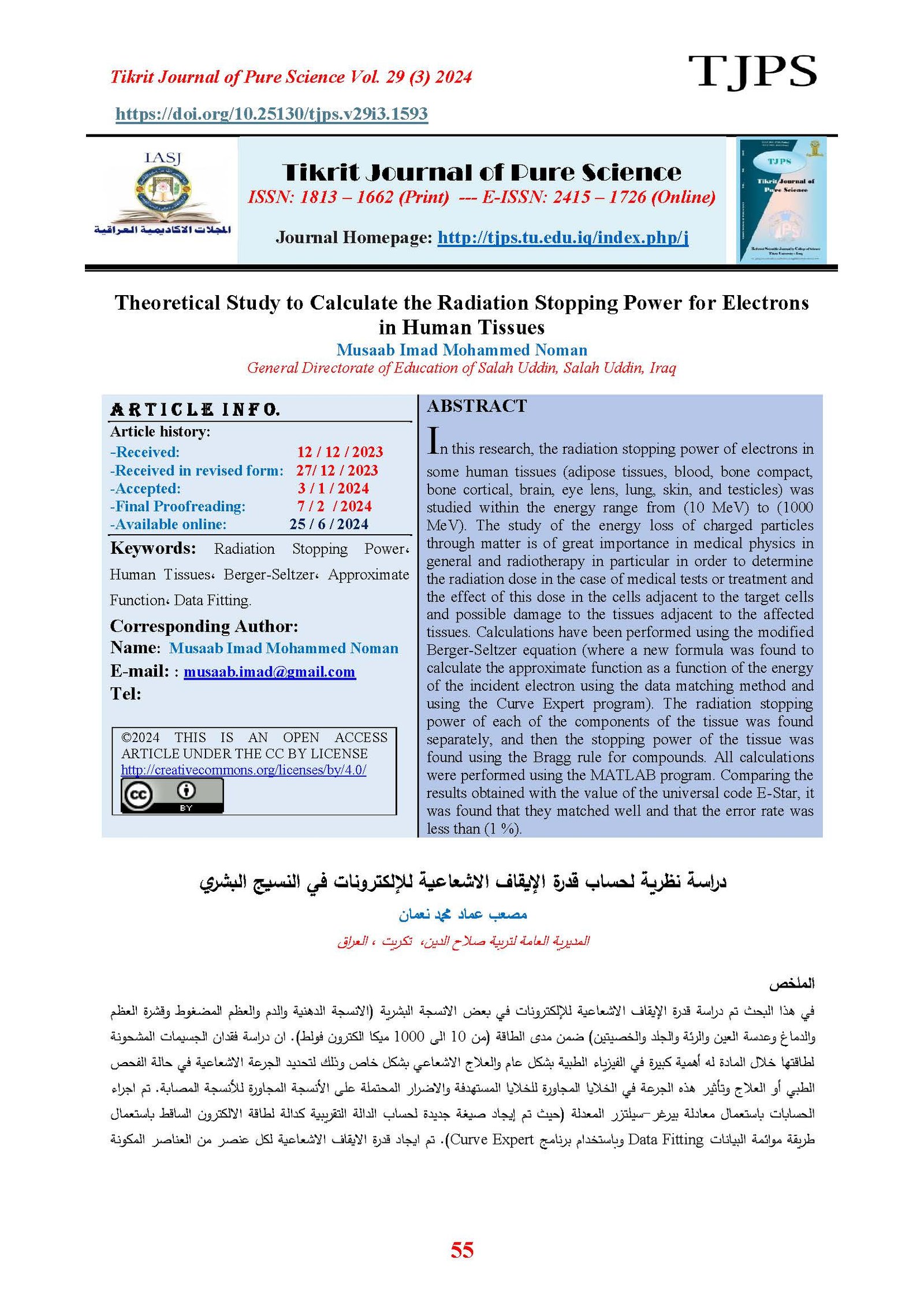A Theoretical Study to Calculate the Radiation Stopping Power for Electrons in Human Tissues
Main Article Content
Abstract
In this research, the radiation stopping power of electrons in some human tissues (adipose tissues, blood, bone compact, bone cortical, brain, eye lens, lung, skin, and testicles) was studied within the energy range from (10 MeV) to (1000 MeV). The study of the energy loss of charged particles through matter is of great importance in medical physics in general and radiotherapy in particular in order to determine the radiation dose in the case of medical tests or treatment and the effect of this dose in the cells adjacent to the target cells and possible damage to the tissues adjacent to the affected tissues. Calculations have been performed using the modified Berger-Seltzer equation (where a new formula was found to calculate the approximate function as a function of the energy of the incident electron using the data matching method and using the Curve Expert program). The radiation stopping power of each of the components of the tissue was found separately, and then the stopping power of the tissue was found using the Bragg rule for compounds. All calculations were performed using the MATLAB program. Comparing the results obtained with the value of the universal code E-Star, it was found that they matched well and that the error rate was less than (1 %).
Article Details

This work is licensed under a Creative Commons Attribution 4.0 International License.
Tikrit Journal of Pure Science is licensed under the Creative Commons Attribution 4.0 International License, which allows users to copy, create extracts, abstracts, and new works from the article, alter and revise the article, and make commercial use of the article (including reuse and/or resale of the article by commercial entities), provided the user gives appropriate credit (with a link to the formal publication through the relevant DOI), provides a link to the license, indicates if changes were made, and the licensor is not represented as endorsing the use made of the work. The authors hold the copyright for their published work on the Tikrit J. Pure Sci. website, while Tikrit J. Pure Sci. is responsible for appreciate citation of their work, which is released under CC-BY-4.0, enabling the unrestricted use, distribution, and reproduction of an article in any medium, provided that the original work is properly cited.
References
[1] Dunn, W.L., & Hugtenburg, R.P. (2006). The Interaction of Radiation with Matter: Charged Particle and Electron Interactions. CERN IEEE Short Course.
[2] Mott, J.H.L., & Daniel, J.M. (2021). Interactions of electromagnetic radiation and subatomic particles with matter–Part 2. Clinical Oncology, 33(7), 455-460.
[3] McParland, B.J. "Nuclear Medicine Radiation Dosimetry - Advanced Theoretical Principles", Springer-Verlag London Limited, (2010). [4] L'Annunziata, M.F. (Ed.). (2012). Handbook of radioactivity analysis. Academic press.
[5] Bichsel, H. and Schindler, H. "The Interaction of Radiation with Matter", Particle Physics Reference Library, Springer, Vol.2, p.p. 5-44, (2020).
[6] Habeb, S.J., & Allah, S.M.A. (2016). Estimation of the total energy loss and continuous slowing down range (CSDA) of positrons in carbon and silver. Tikrit Journal of Pure Science, 21(3), 135-143.
[7] Gibbons, J.P. (2019). Khan’s The Physics of Radiation Therapy. Wolters Kluwer Health.
[8] Podgorsak, E.B. (2016). Radiation Physics for Medical Physicists. Springer.
[9] Mayles, P., Nahum, A., & Rosenwald, J.C. (2021). Handbook of radiotherapy physics: theory and practice. Taylor & Francis Group.
[10] Seltzer, S.M., & Berger, M.J. (1982). Procedure for calculating the radiation stopping power for electrons. The International Journal of Applied Radiation and Isotopes, 33(11), 1219-1226.
[11] Groom, D.E., Mokhov, N.V., & Striganov, S.I. (2001). Muon stopping power and range tables 10 MeV–100 TeV. Atomic Data and Nuclear Data Tables, 78(2), 183-356.
[12] Hadi, S.M., & Saied, B.M. (2019). Stopping power and range of proton interaction with AL2O3, ZrO2 and SiO2. In AIP Conference Proceedings (Vol. 2201, No. 1). AIP Publishing.
[13] Tufan, M., & Gűműş, H. (2008). Stopping Power Calculations of Compounds by Using Thomas-Fermi-Dirac-Weizsäcker Density Functional. Acta Physica Polonica A, 114(4), 703-711.
[14] Detwiler, R.S., McConn, R.J., Grimes, T.F., Upton, S.A., & Engel, E.J. (2021). Compendium of material composition data for radiation transport modeling (No. PNNL-15870 Revision 2). Pacific Northwest National Lab. (PNNL), Richland, WA (United States).
[15] Cember, H. (2009). Introduction to Health Physics: Fourth Edition. Medical Physics, 35(12), 5959. [16] Berger, M.J., Coursey, J.S., Zucker, M.A., & Chang, J. (2017). Stopping-power and range tables for electrons, protons, and helium ions, NIST Standard Reference Database 124. National Institute of Standards and Technology (NIST), Physical Measurement Laboratory (PML).
